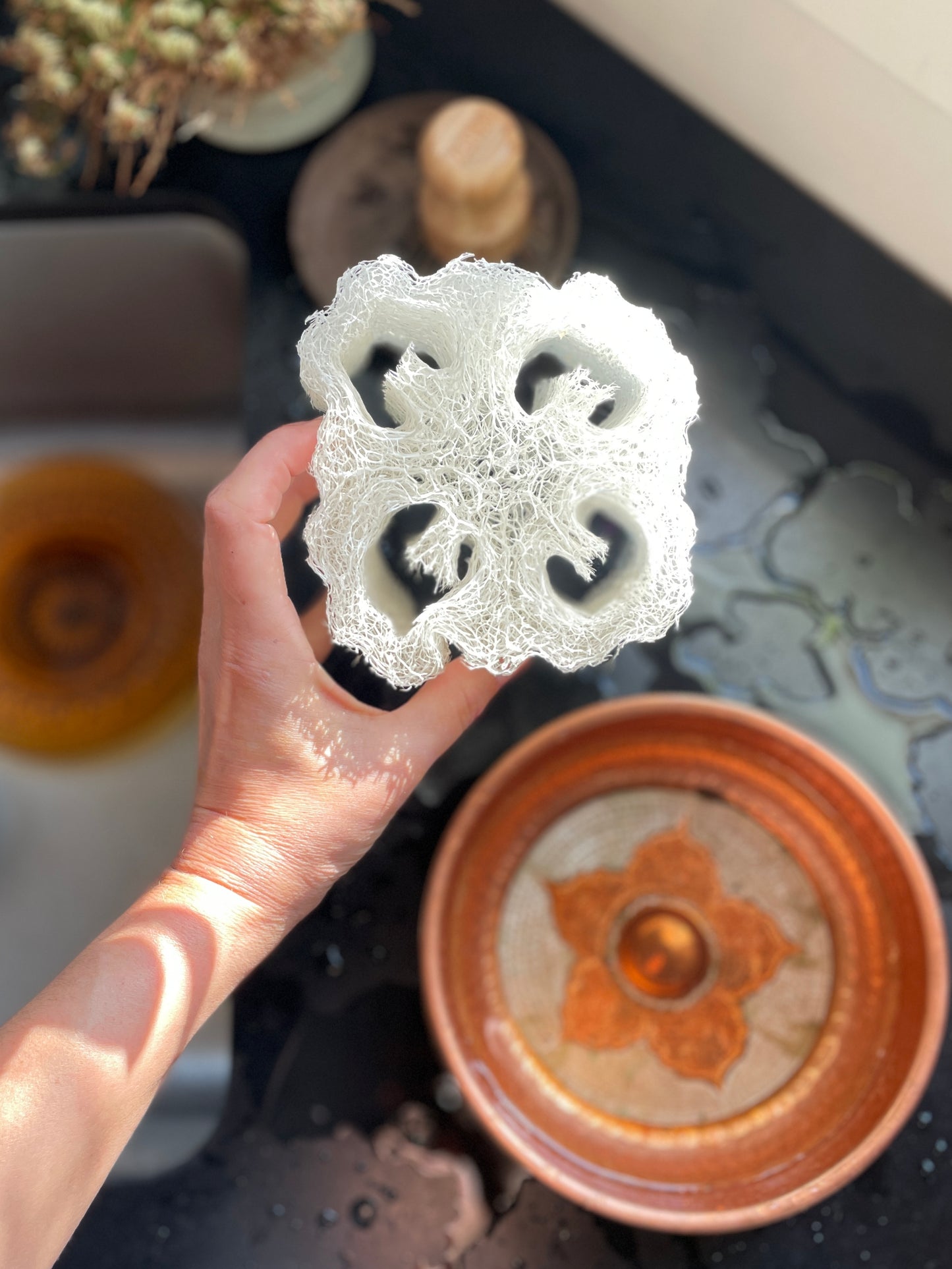


Zero waste cleaning supply, soil aerator, and delicious vegetable-luffa is quite possibly the world's most useful plant!
It seems I was not the only one who had no idea this natural sponge was also an edible plant. Luffa or loofah is a prolific vining vegetable, part of the gourd family that does not in fact come from the ocean as some of us (myself included) once believed! Instead luffa grows best in tropical and subtropical climates around the world. I've literally seen it growing out of sidewalk cracks along the streets of Southern Turkey!
Don't live in a tropical/subtropical climate and want to grow your own sponges too? We got you! Let's dig into the fantastic world of luffa to learn more!
There are two types of luffa, both are edible and both are part of the gourd family along with their cousins the cucumbers, watermelon, zucchini and squash. Almost every part of of luffa including the leaves, flowers, fruit and seeds are edible.
Planting Luffa
Luffa aegyptiaca is also known as sponge gourd, vegetable gourd, angled luffa or Chinese okra. This luffa species has long ridges along the length of the fruit whereas Luffa cyclindrica also known as the smooth luffa, dishrag gourd or Egyptian luffa lacks those ridges. Both are prolific vining annuals (when grown in the right, warm environment) and both produce beautiful yellow blooms that attract pollinators (and are delicious stuffed and fried as you would an Italian zucchini flower).
To plant luffa you will need to find or create the warmest location possible in your garden. At SE Headquarter in Portland, Oregon we grow them against a southern facing brick wall to create a micro climate of warmth and radiant heat. We’ll add a trellis and twine for it to eventually climb up too!
Direct sow early April if your growing season is long. If you live in a cooler climate like us in the Pacific Northwest, you'll want to start them indoors under lights or in a very sunny window at about the same time you would tomatoes, cucumbers, eggplant, (late February to mid March). See more detailed planting instructions here
*Note: Their roots are pretty sensitive to disturbance, so try to start them in biodegradable pots so you can then directly sow them into your outdoor garden! Ideally they make their way outside to be transplanted into a larger pot once the soil temp is 77-95°F. Be sure to set up a place for them to vine as these beauties love to stretch and grow several feet in one season. Imagine a cross between pumpkin and cucumber vines and you’ll have luffa gourd!
*Luffa enjoy a monthly feeding of liquid nitrogen and the vines do soak up A LOT of water so be sure to keep them hydrated during those summer days!
The luffa fruit (vegetable) is best harvested young for ideal texture and flavor. Pick when the fruit is still firm, around 3-4 inches long and no bigger than 2 inches in diameter) After this point they begin to develop their fantastic fibrous texture and should be left to mature becoming that amazing, multipurpose sponge you've been waiting for. At this point you want to allow it to dry out fully on the vine and have a crunchy outer shell before harvesting. That’s when you’ll be able to harvest seeds.
Luffa seeds are best enjoyed roasted as you would pumpkin seeds. Harvest seeds once the gourd has had significant time to dry out on the vine and develop a hard outer shell. This can take many weeks! To remove the seeds, break off the bottom end of the luffa and shake vigorously. Be sure to do this step before soaking your gourd in warm water to remove the hard outer shell as you want to keep those seeds nice and dry. Shake out as many seeds as possible and keep the biggest and healthiest to grow next season.
Next, soak your luffa in warm water and gently peel away the outer shell. It's a very rewarding and relaxing experience.
When planting squash types, choose companion plants to help them grow to their fullest potential. We recommend planting crops like peas, radish or our wild lettuce mix in the soil before planting luffa. When planting (or transplanting) your luffa outdoors, place them beside other companion crops like corn, bran or pea trellising, or beside tall and sturdy sunflowers for optimal soil health and climbing.
It's best to avoid planting luffa, squash and melon varieties near potatoes as well as brassicas like kale, broccoli, and brussel sprouts. They don’t get along and growth is hindered. However, sunflowers, marigolds, nasturtium and borage will increase the overall production by attracting pollinators while warding off common luffa pests. You can find all those beautiful companions in our Edible Flower Collection.
Luffa sponge in your houseplants
Speaking of soil, want to know yet another reason we love growing luffa? It’s a beautiful soil amendment and can help with houseplant drainage. Once your luffa has passed its prime in your home, you can either place it in the dishwasher with the 'heat dry' setting on, or soak it in a vinegar bath for five minutes to kill off any bacteria. Then, chop it into tiny pieces and add to your houseplant soil for added aeration or you can place at the bottom of your planter to keep the drainage flowing while keeping the soil from spilling out.
Luffa in the Garden
Once your luffa has done its job indoors, go ahead and chop into tiny pieces and add to garden soil or place into your compost. Enjoy your new sponges in your kitchen, bathroom or outdoor projects, anything that need a scrub!
LUFFA RECIPES
Sauteed
What you'll need:
2-3 young, firm luffa, peeled and sliced into 2 inch chunks
2-3 tps oil of choice, we prefer coconut or sunflower for this
2 green onions-sliced
2 garlic cloves-mashed
1 tsp minced, fresh ginger
1/4 tsp sugar
1/4 tsp black pepper
soy sauce
steamed rice, steamed greens of choice, crunchy topping options
1. Gather all ingredients together as this is a pretty fast recipe!
2. Heat oil of choice in a large nonstick skillet/pot. Add green onions, along with garlic cloves, and fresh ginger. Stir and cook on medium high heat for 2 minutes.
3. Add luffa to skillet along with sugar and black pepper stir and cook about 5 minutes until the luffa is tender but not mushy.
4. Serve over steamed brown or white rice. Top with a few dashes of soy sauce. Luffa pairs beautifully with egg or tofu. Add some steamed kale, for a delicious meal in a bowl. Sprinkle with sesame seeds, chili flake and/or dried seaweed for added crunch and spice!
Stewed
What you'll need:
-2-3 young, firm luffa fruit peeled and sliced into 2 inch chunks
-2 large eggs, lightly beaten and set aside in a bowl
-2-3 teaspoons oil (high heat)
-1 cup hot water
-1 tablespoon minced garlic
-1/2 teaspoon heat of choice depending on tolerance (chili flake, sliced jalapeño, sliced hot red pepper, milled black pepper corns)
-1/4-1/2 teaspoon salt
-1 cup broth of choice (we use homemade bone broth)
-fresh herbs for garnish (we love dill, parsley or cilantro)
1. In a large skillet heat oil of choice over medium high heat for 15-30 seconds then add lightly beaten eggs and allow to cook for one minute without stirring
2. As soon as eggs are mostly cooked through, toss in luffa and stir together breaking up eggs for 30 seconds
3. Add water, stir and let simmer one minute
4. Add salt, garlic, heat of choice and broth and let stew for 4-5 minutes until luffa is tender but not mushy
5. Sprinkle fresh herbs on top and serve in shallow bowls. Enjoy with flatbread or fresh baguette
Other ways to enjoy luffa:
So happy you're here and hopefully learning more ways to close the loop with us! Replacing plastic and synthetics in your home and garden makes the world a healthier place for us all!
Happy growing,
much love from Karina and Team SE








At 83, I used lufa to shower until I read your articles.
Thanks to you, I will be dining on my young fruits